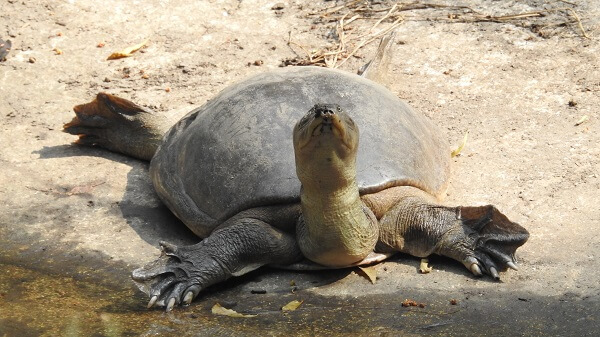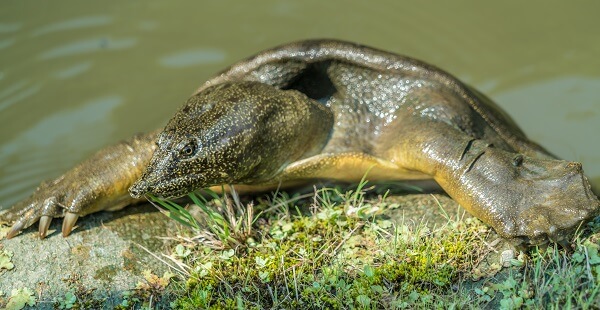
Softshell turtles are freshwater turtles that belong to the family Trionychidae. There are 25 species in total. These turtles are mainly found inhabiting freshwaters such as rivers, lakes, and small ponds. However, some – such as the Nile softshell turtle or Africa softshell turtle (Trionyx triunguis) – have adapted to living in brackish areas. They are found across North America, Africa, Asia, and the Indo-Pacific Islands. Asia has the greatest diversity of species. For example, the Indian and Burmese flap shell turtles (genus Lissemys) are found in slow-moving streams and rice paddies. They are small in size (carapace up to 11 in (28 cm) in length) and mud-colored so that they can go undetected. In contrast, the narrow-headed softshell (genus Chitra) and Asian giant softshell turtles (genus Pelochelys) are much larger with carapaces reaching more than 3 ft (1 m) in length. They are more likely to be found in large, deep rivers. Softshell turtles are mainly carnivorous. They actively seek out their prey or lie in wait and ambush it. These reptiles eat invertebrates, amphibians, and fish, although some species are known to eat plant matter. Softshell turtles usually mate in spring and lay their eggs in the sandy banks above the flood line of a river or a lake. The clutch size varies between species, with some laying as few as three eggs and some species more than 100. Some species can lay several clutches in a single year. Unlike other turtles, the sex of the offspring is not controlled by temperature in softshell turtles. The nests contain both male and female hatchlings. Unfortunately, the main threat to softshell turtles comes from humans. Habitat destruction and pollution not only destroy where they live but can also impact the availability of their prey. Some species are also hunted for use as food and in medicine. More than half of the species of softshell turtles are listed as endangered by the International Union for Conservation of Nature (IUCN). Softshell turtles lack the hard shell or carapace, which is characteristic of most turtle species. Instead, their shell is more like leather than hard and bony. It lacks the large scales known as scutes that make up the hard carapace of other turtle species. The carapace has spines or bumps over it, which can sometimes be used to tell the species apart. The smooth softshell turtle is the only softshell turtle without spines and bumps on the carapace. These turtles have long, elongated necks, a streamlined head, and a pointed snout. The nostrils are found on the top of the snout. This enables the turtles to bury themselves in mud, sand, and shallow water and still breathe. The turtles do this by extending their head so that the snout just breaks the surface. This family of turtles is fascinating to study due to their soft, flattened shell and their ability to remain submerged underwater for long periods. These turtles demonstrate many amazing biological concepts that make them well adapted for their aquatic life. Let’s take a closer look at some of them: Softshell turtles hibernate for the winter, burying themselves in sand and mud at the bottom of a river, lake, or pond. The turtles don’t need to eat during hibernation, but they do still require oxygen, albeit at a reduced rate. These turtles have adapted to hibernation by using something called pharyngeal breathing. The turtles can absorb oxygen across the skin and the lining of their throat, or pharynx, which is where the name pharyngeal breathing comes from. Softshell turtles absorb 70% of the oxygen they need through their skin. The remaining 30% is absorbed by the animals pumping water in and out of the pharynx. There are many villi, or small projections of tissue, within the pharynx that has a supply of blood vessels. These villi provide a large surface area for oxygen absorption to take place. This method of breathing underwater is unique and differs from the mechanisms used by other turtle species. Other turtle species breathe underwater through their cloaca. The cloaca is an opening at the back of their body, which is used by the excretory, digestive, and reproductive systems. These turtles have cloacal bursae, which are a pair of small pockets that have a rich blood supply. This allows the turtles to remove oxygen from circulating water in the same way that softshell turtles do in their pharynx. Without the protection of a hard shell, the softshell turtle has had to adapt to their environment to avoid predation. Softshell turtles are surprisingly rapid swimmers and use their speed to catch prey or escape predators. These turtles have strongly webbed feet, which enable them to propel themselves through the water at surprising speeds. Through evolution, the turtles lost their shell, and this has allowed them to become more maneuverable and faster in the water. The flattened shape of their body is also surprisingly hydrodynamically efficient, helping them to move quickly. While softshell turtles found in temperate areas can remain active all year round, those found in more northern regions may hibernate as the temperatures get cold during the winter. Turtles go into brumation, which is a period of dormancy that some reptiles experience. It is similar to true hibernation experienced by mammals. Turtles are ectothermic, which means they are cold-blood. The environment influences their internal body temperature. When temperatures begin to decrease in the fall, turtles can go into hibernation. They bury themselves in the mud or sand at the bottom of a river or lake and go to sleep. Their body temperatures decrease, and their metabolism lowers. They become dependant on stored energy and oxygen in the water to meet their minimal needs. Like we talked about earlier, breathing occurs through their skin or pharynx. When the temperatures increases in the spring, the water warms, and the turtles awaken from their sleep.
Kingdom
Animalia
Phylum
Chordata
Class
Reptilia
Order
Testudines
Family
Trionychidae
Genus
13
Species
25
Niche
Carnivorous, will lie and ambush its prey
Length
Variable: Smallest carapace length is 4.7 in (12cm), largest > 47.2 in (120cm)
Lifespan
Range from 20 to 50 years.
Social Structure
Solitary animals
Conservation Status
Critically endangered: 5, endangered: 5, vulnerable: 6
Preferred Habitat
Aquatic, freshwater
Average clutch Size
Wide range
Main Prey Species
Invertebrates, fish, and amphibians
Predators
Humans. Snakes and birds may prey on their eggs
The Basics

Softshell Turtle Anatomy

Interesting Insights from the Softshell Turtle!
Pharyngeal Breathing
Adaptations for Swimming

Hibernation
